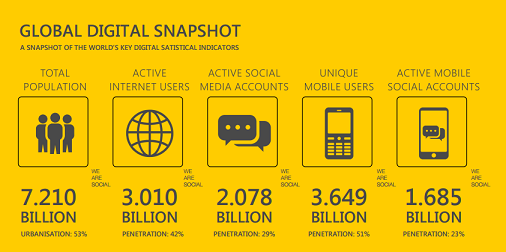
 With an increase in the usage of mobile phone and mobile phone Internet, consumers are forcing a digital transformation that must have mobile experience.
With an increase in the usage of mobile phone and mobile phone Internet, consumers are forcing a digital transformation that must have mobile experience.
More than the quarter of the world population will be using smartphones as projected by eMarketer (2 billion smartphone users). This means billions of mobile phones in the hands of billions of people, whom you need to engage as a brand.
Leading Brands will become More Screen Agnostic
“Today, more than 50% of a person’s time spent is with digital-social-mobile (DSM) media and channels, and over 90% of media consumption occurs across a digital display, including TV. Thirty-six percent of retail sales, or $1.5 trillion, is influenced by DSM, and 86% of people use mobile to influence their shopping decisions,” says Michael Becker, co-founder and managing partner of mCordis. Numbers like these reemphasize the importance of mobile in the digital strategy in 2015. Hence, companies will have to transform to engage digital and mobile users.
More Marketing Dollars will Shift to Mobile
Since consumers will demand amazing mobile experiences in the time to come, marketers will have to revamp their marketing strategies. This will provoke the marketers to shift their focus and investment from what they have i.e. desktop web marketing to what’s trending which is mobile marketing.
Mobile analytics and optimization technologies will also gain momentum to provide relevant, personalized and location-based experiences for users of mobile apps.
Marketers will have to clearly understand the differences and similarities between website and mobile marketing. While differences will include the app store ecosystem, cross-device measurement, and messaging tactics that include SMS, push, and in-app advertising, similarities will include the urgent requirement to acquire responsive and mobile websites to give your users a seamless web experience.
If you are not a mobile first marketer then a combo of formal education, training, and hands-on experience can help you win the race.
Apps within Mobile Marketing Strategy will Gain Momentum
To be more compatible with the current mobile revolution, brands will have to make dual investments in both mobile apps and mobile websites. A report by Adobe reveals that 30% of U.S. companies are spending upward of $10 million on apps and mobile web. Brands will have to look forward to create high utility apps that are sticky and forces consumers to use it time and again. These apps will have to be analytical as well, so as to understand consumer behavior and respond accordingly. Hence, regular updates of these apps will also be a necessary part of creating the apps.
As for mobile web, brands will rather invest in responsive websites than the standard m.dot sites. Brands will have to focus on providing a fast, relevant and seamless web experience to users since website is the first touch point between consumer and brands. Further, responsive websites must be enabled to deliver subsecond response time to user based on the device he is using.
Since, we are moving to a world where everything is literally going digital, the challenge of being present and relevant across an array of digital devices is difficult to manage for many marketers. It is here, when responsiveness comes to rescue with real time marketing that is fast, flexible, fluid and contextual.
Location-based Targeting will become a Priority
According to survey conducted by Adobe, 54% of the marketers surveyed are using or planning to use iBeacons in the next 12 months for location-based marketing. Many retailers, travel and hospitality brands, and media companies with physical venues are already using location-based marketing across various points of interests. Therefore, to reduce the barriers to adoption of location-based marketing brands will have to focus on educating consumers on how location technology can provide them relevant and necessary information.

Asif Khan, Founder and President of the Location Based Marketing Association on CMO.com says that in 2015 ‘location will be seen as the new cookie’ and it will help to track the movements of consumer during the day and across the media platforms that will also include TV, radio and OOH. He further says that marketers will heavily spend on mobile/location infrastructure support with the growth of next-generation GPS and improvements in indoor location technology like iBeacons. Consumers will also keep aside privacy and ethical inhibitions and will readily trade their data on the true value premise for the content that is personally relevant and beneficial for them.
Mobile personalization will be the next big thing
Mobile phones and tablets are a very personal medium of communication. Consumers, therefore, look forward to messages that are more personal and relevant and they expect marketers to deliver what they expect. Since this expectation extends to all digital channels and devices, marketers will look forward to invest to improve their mobile relationship management strategy.
They will make every effort necessary to personalize every mobile touchpoint of scale, across the entire customer journey of millions of customers. Last year a lot of companies gained with their investments on mobile personalization by generating significant incremental value. Though mobile personalization is a prime opportunity, it is a challenging avenue. To make the most out of it, marketers will have to co-ordinate and personalize the message across all the mobile channels.
Mobile A/B testing will become essential for increased ROI
With a gradual yet dramatic shift of consumers from PCs to smartphones, marketers are bound to increase the monetization of their apps and mobile website experience in 2015. The conversion rates from the smartphones and tablets have a wide scope improvement with optimization and technology in the times to come. This brings in the importance of A/B testing more than ever in the scope.
A/B testing will help the marketers test new features and marketing programs, which will reduce the investments and make it cost effective. Further, mobile optimization efforts will be optimized, which will validate the important parts of mobile user experience with live audiences. This will help the marketers gain higher conversions, revenue growth with cost savings.
In 2015, mobile optimization will become more critical with an increase in mobile phone Internet usage for search and purchases. Hence, marketers will have to focus on their website that will give seamless mobile experience first and then focus on the other digital media channels.
Mobile Advertising will Break the Desktop Shackles
The mobile advertising trends of the recent past show that ad spends on mobile specific ads is much less than the time consumers spend on their mobile phones. But, that won’t be the case in 2015. This year will witness a growth in mobile advertising. According to Forrester, mobile advertising will grow and reach $46 billion by 2019 in US alone.
With more and more people shifting to mobile Internet and adoption of 4G services in near future, short mobile videos will become a powerful mobile advertising tool. On the mobile search front, eMarketer predicts that 2015 will see mobile search at an all time high with majority of spend, organic traffic and paid clicks coming from smartphones and tablets, surpassing traditional desktop/laptop search activity.
Programmatic advertising will be a key driver of mobile ad spends. With improved targeting technologies, marketers will look forward to buy audiences and not media channels, which means that a majority of ad placement will be done by algorithms with little human interventions. Hence, in 2015, marketers will look forward to develop, refine and optimize favorable algorithms.
Researches prove that maximum mobile video viewing happens between 9 p.m. to 11 p.m. when consumers are at home, it is advisable that marketers embrace the small screen and consider mobile as an essential for their online video strategy.
Engagement on mobile will become critical to customer retention
A study by Forbes reveals that 90 percent of mobile searches lead to action, more than half lead to sale, and 74 percent of people use their mobile phones to assist them for shopping. Mobile marketing is thus, gradually pacing up as a primary digital marketing channel, since a mobile is emerging as an extension of your customer which is extremely personal and immersive as compared to other media channels.
Mobile marketing is also coming up as a leading channel for inbound marketing. However, mobile marketing is not just about buying and placing more mobile ads, its more about engaging your existing customers with in-app engagement using relevant notifications and valuable content. It is about using the right push points for customer retention.
Games will continue to spearhead engagement
The best way to involve and engage your audience is a gaming app. Your general mobile app can also be equipped with gamification features to target the audience and to keep them coming back to the app for more. A stand-alone gaming app is also something that can win you leads and engage your consumers.
In 2015, event apps will look forward to gamification features. One good way to do it will be to build out a prize pack by involving sponsors. Let your plan be backed by big rewards to ensure engagement with features that benefit your business as well as your consumers. As a gaming app, you can reward your consumers in the form of free chips/coins/game currency
Privacy and data ownership will be critical
In 2015, marketers will focus more on creating policies for digital privacy governance. Emphasis will be laid on making policies that clearly demarcate what data is collected from consumers, how it is used for marketing, how will this data be shared with third parties and how can consumers opt-out or opt-in from data sharing.
On the other hand, consumers will expect simpler ways of data sharing opt-in methods for data collection, location services and other push services. They would expect marketers to make these processes more transparent for privacy and security reasons.
Conclusion
There is a definite shift in the digital media when it comes to mobile strategy in 2015. There will be an increased focus on mobile for internal collaboration. Mobile will also be a pivot of change in the evolution and user behavior on new and existing social behaviors. The number of mobile websites and apps will also see a rising trend. This will increase consumer stickiness and drive more engagement around the brand. In a nutshell, investing mobile strategy is a necessity that will bring in good returns.
Your investment in a good mobile marketing strategy can change a cost center to a profit center!
To download the full report on Mobile Marketing Trends for 2015,click HERE.
Source: www.pulpstrategy.com
